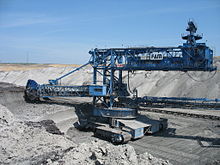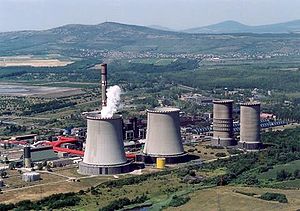Mátra power plant
| Mátra power plant | |||
|---|---|---|---|
| Matra power plant from the southeast | |||
| location | |||
|
|
|||
| Coordinates | 47 ° 47 '25 " N , 20 ° 3' 45" E | ||
| country | Hungary | ||
| Data | |||
| Type | coal-fired power station | ||
| fuel | Lignite (with additional combustion of biomass and natural gas ) | ||
| power | 936 MW el , consisting of:
|
||
| owner | Mátrai Erőmű ZRt. (Mátra Kraftwerk Closed AG), subsidiary of:
|
||
| Project start | 1965 | ||
| Start of operations | 1969 | ||
| Website | www.mert.hu/de | ||
The power plant Mátra ( Hungarian : Mátrai Erőmű , even (heat) power plant Visonta , Gyöngyös or Gagarin called) is a brown coal - power plant near the village of Visonta in the small area Gyöngyös east of the town Gyöngyös at the foot of Mátra in Hungary .
It is supplied with fuel via conveyor belts directly from the Visonta opencast mine in the south and by rail from the Bükkábrány opencast mine 60 km to the east . In addition to lignite, a small amount of biomass is also used.
The power plant is the second largest power plant in Hungary after the Paks nuclear power plant; it supplies about 15% of the Hungarian electricity production. Because of its size and because it does not depend on imported fuels, but is fed entirely from domestic resources, the Mátra power plant is an important pillar of Hungary's national energy supply.
With its height of 203 m, the chimney is one of the ten tallest structures in Hungary.
History and structure

Construction of the power plant began in 1965. At first it was named Gyöngyös Thermal Power Plant (Hungarian: Hőerőmű Gyöngyös ). During the construction phase, in 1968, it was given the nickname Gagarin in honor of the Russian cosmonaut Yuri Gagarin, who had just died in an accident . In 1969 the power plant went into operation with the first 100 MW block. By 1972 the power plant was expanded to five units , including 2 × 100 MW and 3 × 200 MW.
The condenser cooling for the blocks I, II, IV and V is carried out via two natural draft - wet cooling tower (in the image center), for the block III two force-ventilated tower cooler with film cooling (on the right). Since cooling water is scarce at the site - there is no major river - the cooling towers run in a circulation process .
The facility was modernized for the first time between 1986 and 1992.
In 1992 the power plant and the associated opencast mines were privatized and a closed stock corporation ( gAG , Hungarian: ZRt. ) Was founded under the name Mátrai Erőmű (German: Mátra Kraftwerk) . The main owner was initially the Hungarian state energy supplier Magyar Villamos Művek (MVM). A short time later, in 1993, RWE Rheinbraun got involved and initially acquired a minority stake of 26.5%. In 1995 the RWE stake was increased to 51%, so that RWE got the majority of the shares. At the same time, EnBW also got on board with 22%. The remainder stayed with MVM (25.5%) and others (1%).
This was followed by even more extensive repairs and modernization between 1998 and 2003, during which, in addition to performance-enhancing measures, a flue gas cleaning system with desulphurisation was retrofitted. Since then, Mátra has complied with western environmental standards and is one of the most environmentally friendly coal-fired power plants in Eastern Europe.
Between 2005 and 2007, two of the 200 MW units were treated with a Vorschaltgasturbine equipped, each of which a maximum of 33 MW el provide power and also by improvement in efficiency the performance of the carbon block increased by about 10% so that total for the power plant to increase power by yielded about 100 MW el .
There were plans to expand the power plant. A new, modern lignite block with an output of 400 MW el should be built by 2014 . In the course of this, the proportion of biomass in the fuel for the entire power plant should also be increased. The project failed because of the unclear allocation of CO 2 certificates and the unsecured funding. It was planned that MVM would hold 75% and Mátra Kraftwerke GAG, the operator of the existing power plant, would hold a 25% stake. Instead, between 2015 and 2017, the 200 MW units were renewed for the second time and their output increased; the gas turbine renewal followed in 2019. By 2020 primarily coal is to be burned in the power plant, later the proportion of biomass, gas and other secondary fuels is to be gradually increased . The operation of the power plant is planned until at least 2030 (as of December 2018).
See also
Individual evidence
- ↑ a b c Frank Johannes Schippers, RWE: The Matra Project in Hungary , in: bergbau 3/2008 ( Memento of the original from January 27, 2016 in the Internet Archive ) Info: The archive link was inserted automatically and has not yet been checked. Please check the original and archive link according to the instructions and then remove this notice. (PDF; 2.0 MB)
- ↑ a b Mátra Erőmű - Power Plant on www.mert.hu
- ↑ RWE Power and EnBW sell stake in Hungarian company Mátra , RWE press release, December 14, 2017, accessed on June 10, 2019
- ↑ a b c Matra power plant at www.ostkohle.de
- ↑ a b EnBW and RWE modernize the Hungarian (sic) power plant at www.strom-magazin.de
- ↑ Germany Trade & Invest: New power plant projects in Hungary are taking shape on www.gtai.de ( page no longer available , search in web archives ) Info: The link was automatically marked as defective. Please check the link according to the instructions and then remove this notice.
- ↑ Tóth Balázs: Változások az erőműnél, a harmincas évektől le kell mondaniuk a szénről , in heol.hu, December 6, 2018, accessed on June 10, 2019 (in Magyar)

